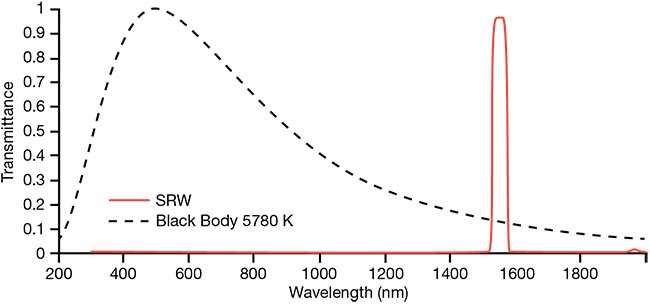Full company details
Iridian Spectral Technologies
Div. of IDEX Optical Technologies
 2700 Swansea Crescent
2700 Swansea Crescent
Ottawa, ON K1G 6R8
Canada
Phone: +1 613-741-4513
Fax: +1 613-741-9986
Advanced Filters Help Space Lasers Deliver Internet from Above
Photonics Spectra
Mar 2024Advanced optical filters are improving laser-based satellite communications by enabling ‘more signal and less background.’JASON PALIDWAR, IRIDIAN SPECTRAL TECHNOLOGIES, AND DAVID SAMUELS, ADVANCED THIN FILMS
Rapid, on-demand access to information is a necessary facet of daily life in the present “age of communications.” The reliable communication links that society necessitates support person-to-person and device-to-device communications at any time and, increasingly, in any place.
Such assurances of connectivity owe to the massive technological strides of the past half century. Now, as with many technology hallmarks of the previous 50 years — spanning hardline telephony to the current ubiquitous smart devices — the pending evolution in the field of communications is poised to require a substantially broadened reach. Networks must extend beyond the existing and forthcoming physical infrastructure of wireline fiber optic networks and wireless cellular base stations. Anticipated advancements beyond 5G and machine-to-machine supporting the Internet of Things will require blanketing the planet with high-speed, ultralow-latency, secure networks.

Courtesy of iStock.com/Epstudio20
Satellite communications (satcom) presents a viable supplement to terrestrial telecom in the quest to achieve future communications needs. Indeed, the
technology has been part of a global communications networks vision since the launch of the Telstar 1 and Telstar 2 communications satellites in the early 1960s
1,2. And, after more than 170 orbital launches — comprising nearly 2500 unique satellites — in 2022, the number of launches last year exceeded 200.
Recent estimates indicate that there are more than 5000 satellites in orbit that are supporting communications alone.
Laser communications fills space
In terrestrial telecom optical networks, lasers generate optical signals that are transported between network nodes on the fiber optic backbone network. The optical intersatellite links (OISLs) that connect the mesh network of satellite constellations also use lasers, for the purpose of optical signal generation.
The difference between these mechanisms is the transport media through which the signal is propagated. In OISLs, space itself functions as the medium.
Industry adopted the term “lasercom” to describe these fiberless free-space optical networks. They may be associated with communications with a satellite — either OISLs or ground-to-satellite-to-satellite-to-ground links — or other communication networks within the bounds
of the Earth’s atmosphere.
After traditional satellite communication based on microwave or radio frequency (RF) bands carried the communication technology into the present era of innovation, lasercom became the dominant linking technology for truly global satellite communication constellations. Lasercom links, which can operate at frequencies ~105× faster than those of RF systems, offer advantages, including increased data rates due to a larger modulation bandwidth. Further, lasers offer narrower beam divergence that scales with wavelength, which leads to higher intensity at the receiver, the option to use smaller antennae and/or optical components, reduced risk of interference between signals, and more secure communications.
These advantages enable a constellation connected by OISLs to ensure that data is rapidly and securely uplinked and routed around the world in a closed network before being downlinked to a terrestrial terminal at the intended destination.
The role of optical filters
Driven by a desire to pack as many optical signals as possible simultaneously onto a single fiber, wavelength division multiplexing (WDM) modules exploded onto the market during the telecom boom of the late 1990s. These modules use wavelength-selective optical filters to combine, route, and deliver — add and drop — optical signals at different wavelengths in the near- to shortwave IR. The bulk of the signal is carried in the C-band between 1530 and 1560 nm.
Lasercom networks, similarly to their Earth-based telecom predecessors, function to combine multiple signals on the same optical path, selectively route the signal to the desired detectors, and selectively discriminate the signal information from the background noise and competing signal channels. To the delight of systems engineers, 30 years of development has rendered the production challenges associated with technically demanding filters relatively well understood. Lasercom OISL systems have built on the legacy telecom component infrastructure, adopting the use of light sources in the C-band and similar wavelength-selective optical filters.
Still, the inherent challenges in performing space-based applications, particularly in lasercom, pose a set of
distinct considerations and requirements for adapting this optical filter technology.
Unlike fiber optic networks, where the fiber medium inherently restricts the natural tendency of light beams to expand as they travel, affordable free-space
applications allow only a miniscule fraction of the signal that is sent to be received. By the time this signal reaches the next OISL in its network, it has expanded to tens or hundreds of meters across. As a result, OISL filters must be relatively large — often 1 to 2 in. in diameter — to capture a sufficient portion of the beam for the signal to be detectable.
Further, solar rejection filters (SRFs), or solar rejection windows, are required at the input of the optical telescopes to allow only signal band wavelengths into the satellite. This maximizes signal-to-noise at the receiver and reduces solar heating within the optical system. SRFs themselves are often several inches in diameter.
Using large filters requires very uniform coating performance. In this domain, the precise wavelength-selective edge and/or bandpass filters that are needed for space-based lasercom systems present a distinct challenge compared to those that are typical of large-size optics, such as mirrors or simple antireflection coatings. Uniformity is necessary to preserve spectral performance across the clear aperture and ensure that engineers minimize coating- and substrate-induced contributions to transmitted wavefront distortion. This minimization is crucial since the distances that the laser light travels between nodes is critical to preserve data quality through minimizing the distortion of the signal wave by the optical components themselves.
Beyond the different functional requirements, satellite-based optical filters must be designed and manufactured to withstand the demands of operation outside of Earth’s atmosphere. This includes radiation survival and large temperature swings — from operation in sun-facing situations as well as in complete darkness.
Designers must also consider application-agnostic specifications that influence filter performance. These fall beyond the scope of distinct requirements for space-based performance. Ripple, transmission and rejection levels, and surface quality are among these core considerations.
Because the use of lasercom links instead of microwave bands can ensure more secure communication, establishing
possibilities for encryption using quantum key distribution (QKD), designers may face occasional requirements related to encryption. Polarization preservation requirements associated with QKD
encryption may be an area of focus in filter design and manufacture for these types of systems.
Finally, the requirement for larger filters also opens a path to misconceptions related to this critical component. For example, designers may commonly correlate filter flatness and/or substrate parallelism to low wavefront distortion. Low wavefront distortion is required to obtain optimal system performance.
In fact, although flatness influences the characteristics of the reflected beam, variations in spectral performance will typically dominate flatness or even parallelism effects for the transmitted beam, especially over large part sizes.
It is critical that system designers be aware of these challenges and avoid over-specifying transmitted/reflective wavefront distortion needs. At the same time, filter designers and manufacturers must predict, control, and characterize coating effects on transmitted/reflective wavefront distortion.
Prospects for polarization
Amid the challenges with sustaining OISLs in space-based environments, system operation in the regime of Earth-orbit distances also creates advantages. In the absence of an interfering optical medium, for example, laser polarization is maintainable over long distances without interference from atmospheric particles and/or aerosols.
As a result, polarization, as an additional channel for read/send isolation or as a supporting feature to improve wavelength multiplexing isolation, is present in a system designer’s toolkit.
Coatings for polarizers are thinner than those needed for WDM applications, which means that polarizers tend to be much less sensitive to wavefront distortion induced by coating nonuniformity. Because, however, the polarizing surface is oriented at 45° to the inbound beam and the input and output faces of the assembly, the wavefronts of both transmitted and reflected beams are extremely sensitive to any lack of flatness in this surface. Maintaining wavefront levels through fabrication, coating, and assembly is a crucial and highly challenging aspect of manufacturing and subsequently using these components.

The number and frequency of objects launched into orbit reflects a full-scale democratization of space. Nearly 2500 distinct launches in 2022, along with SpaceX’s Starlink’s proposed
network of more than 30,000 individual satellites, highlight the prominence of space-based communications. Courtesy of IDEX Corp.
There are additional ways to use the Faraday effect to build isolators that can operate in polarization-insensitive fashions to separate send and receive signals inside the laser terminal. Such products are widely deployed in terrestrial laser communication networks. Although shifting from the regime of fiber-restricted signals to long-distance free-space laser beams requires designers to overcome a range of complicated factors, designers have hypothesized products suitable for such applications for decades. Now, recent improvements in self-latching garnet materials have made it more likely that these products will be realized in production.


The requirements of using large filters can lead to misconceptions around the properties of the reflected and/or transmitted beam (top). Flatness, for example, affects the characteristics of the reflected beam — though variations in spectral performance will typically dominate flatness or even parallelism effects for the transmitted beam. Courtesy of IDEX Corp.
An example of an Iridian solar rejection filter. Solar rejection filters, or windows, are positioned at the input of a telescope to allow only signal band wavelengths into the satellite system (bottom). These filters, which reduce solar heating within the optical system, serve to maximize signal-to-noise at the receiver. Courtesy of IDEX Corp.
Research into polarization free-space optical communication remains in its relative infancy. In some ways, the challenges related to scaling WDM filter manufacturing, from components used
for terrestrial applications to those
needed for space optical communications, parallel the obstacles that designers and manufacturers of advanced polarization-controlling components are facing. It remains unclear which components designers will need for the systems under development. Although bonded assemblies featuring dielectric-coated polarizers are the selection of choice in this application, the same highly sensitive wavefront requirements apply across the larger surfaces of these assemblies, because these assemblies may need to be 1 to 2 in. on a side to accommodate the larger beam sizes that the application commands.
Another roadblock is that any advancements that use polarization as an isolation feature must be developed on top of the
existing architecture of components and communication protocols developed for terrestrial applications. The most typically
used fibers in long-haul terrestrial fiber networks are not polarization-maintaining in nature. Network functionality does not rely on polarization, meaning that this feature serves to drive up component costs for existing architectures.
The future is present
As with anyone working to shepherd
sophisticated technology into an uncharted era, none of us claim to know what we do not know. And, given the historically risk-averse nature of design for use in space, initial demands on filter performance and demonstrated reliability are, on occasion, subject to unnecessary demands. This “spec creep” can drive
increased costs and lead times, which can influence designing, manufacturing, and testing the optical filters to meet these “space standards.”
But it is certain that with substantial benefits to legacy microwave and RF band-based satcom, constellations of satellites are anticipated to continue to deploy at increasing launch rates. Further, given the short — approximately five-year — replenishment life cycle, the market will continue to need lasercom systems and ensure opportunity for these systems and their components to improve and evolve to address ever-changing needs for more secure bandwidths and higher data rates. Consumer internet and government communication networks are among the principal deployments envisioned for the technology.
At the same time, Earth is not the final frontier. Lasercom has already been demonstrated for Earth-to-lunar communications and so it will almost certainly serve as the key communication link as humanity expands its footprint to the moon, Mars, and beyond. Ad astra, per aspera.
Meet the authors
Jason Palidwar is director of business operations for Iridian Spectral Technologies, a part of IDEX Optical Technologies. He has worked to provide optical filter solutions, in support of many photonics applications, for 25 years; email:
[email protected].
David Samuels, director of business
development for Advanced Thin Films, a
part of IDEX Optical Technologies, has
20 years of industry experience. He holds degrees in physical chemistry and a specialization in optics from Rice University and the University of Colorado; email:
[email protected].
References
1. S. Mottini and L. Bonino. (2016). Optical Links for Fast and Secure Communications on Ground and in Space. Thales Alenia Space Italia, pp. 1-14.
2. O.A.A. Al-Selwi and A. Babiker. (2017). Comparison of Microwave and Optical Wireless Inter-Satellite Links.
International Journal for Research in Applied Science and Engineering Technology (IJRASET), Vol. 5, No. 6, pp. 673-677.